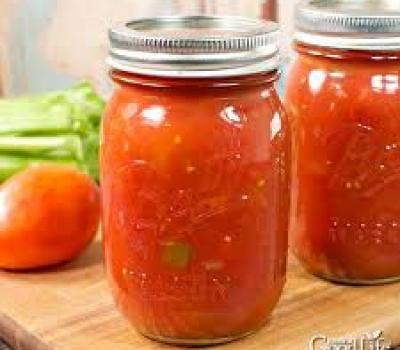All tags
5 star recipes
A
air fry
alcohol beverages
Beverages
BREADS
Breakfast
cakes
Candy
Casseroles
charcuterie boards
Chicken
chili
Chinese
Chowder
Christmas
coffee cakes
Conversion Chart
cookies
dale.
DESSERTS
DIPS
easter
fish
Freezer Meals
Friends
Halloween
herbs/spices
jan's canning
jan's ice cream
meat
Mexican
MISC
Muffins
new years
pasta
Pastry
Pies
polish
Potatoes
potpourri
pressure canner
QUICK BREADS
Rice
Salad Dressings
SALADS
sandwich spreads
Sandwiches
Seafood
Skillet
SNACKS
Soup
st. patrick
Stews
summer
t
Thanksgiving
Vegetables

Pressure Canning Stewed Tomatoes
Capture the vibrant flavors of ripe tomatoes, celery, onions, and peppers in jars with this step-by-step guide to pressure canning stewed tomatoes. Your pantry will be stocked with jars of natural goodness, ready to elevate your recipes.
Ingredients
16 cups peeled, cored, chopped tomatoes (about 8 pounds before prep)1 cup chopped celery (about 2 stalks before prep)
1/2 cup chopped onions
1/4 cup chopped seeded green bell pepper
1 tablespoon optional for flavor
2 teaspoons optional for flavor
Instructions
Prepare the Canning Equipment:Wash the jars, canning lids, and rings in hot soapy water and rinse thoroughly. Set the lids and bands aside until you are ready to use them.
Place the jar rack into the pressure canner, and fill with water per your pressure canner manufacturer's instructions: Presto is 3 quarts, Mirro is 2 quarts, and All American is 2 to 3 inches.
Fill the jars halfway with hot water, and then place them on the rack in the canner.
Bring the canner to a simmer for 10 minutes (180˚F). Keep them hot until you are ready to fill them.
Simmer the Tomatoes and Vegetables:
Add the prepared tomatoes, celery, onions, peppers, sugar, and salt to a large stainless steel saucepot, and stir to combine.
Bring the mixture to a boil over medium-high heat, then reduce the heat, and simmer (180˚F) for 10 minutes. Stir occasionally to prevent sticking.
Fill the Jars:
Lay a towel on the counter. Use your jar lifter to remove a jar from the canner. Pour out the water (save it for washing dishes), and place the jar on the towel. Keep the remaining jars in the canner so they stay hot.
Use your canning funnel and ladle to fill the jar with the hot mixture, leaving 1-inch headspace.
Remove air bubbles with the bubble popper, wipe the rim to remove any residue, center a lid on the jar, and screw on a band until it is fingertip tight.
Use the jar lifter to place the jar back into the canner and repeat with the remaining jars.
Can the Stewed Tomatoes:
Place the lid on the canner and lock it. Leave the vent open, adjust the heat to medium-high, and bring the canner to a boil. Allow the pressure canner to vent steam for 10 minutes, place the pressure regulator on top of the air vent, and let the pressure rise.
Once the canner has reached the correct pressure (10 pounds for weighted gauge and 11 pounds for dial gauge pressure canner), set a timer and process pint jars for 15 minutes, and quarts for 20 minutes at altitudes of less than 1,000 ft.
Adjust altitude if necessary (see chart below), and regulate the heat as needed to maintain a steady pressure.
When the processing time is complete, turn off the heat, and let the pressure canner cool down to 0 pressure. Once the canner is depressurized, let the canner cool additional 10 minutes before removing the lid.
Spread a dry towel on the counter, unlock the cover, and remove it by tilting the lid away from you so that steam does not burn your face.
Allow another 10 minutes for the jars to adjust to the change in pressure. Then, if the jars are still boiling vigorously, let them sit in the canner for another 5 minutes or until the boiling slows.
Use the jar lifter to lift jars carefully from the canner and place them on the towel. Keep the jars upright, and don't tighten bands or check the seals yet. Let the jars sit undisturbed for 12 to 24 hours to cool.
After 12 to 24 hours, check to be sure the jar lids have sealed by pushing on the center. The cover should not pop up. The jar failed to seal if the top flexes up and down. Refrigerate it and use it within a few days.
Remove the screw-on bands and wash the jars in warm soapy water. Label, date, and store the jars in a cool, dark place for 12 to 18 months. Once the jar is open, refrigerate and use up within a week. Yields about 6 pints or 3 quart jars.
Notes
This recipe is a tested, safe canning recipe from the Ball Blue Book Guide to Preserving book. Changing the recipe may make the product unsafe for canning.
All times are at an elevation of less than 1,000 ft. Visit whatsmyelevation.com to check your elevation and adjust the processing time if necessary. Make the following adjustments for altitudes greater than 1,000 ft. using the chart below.